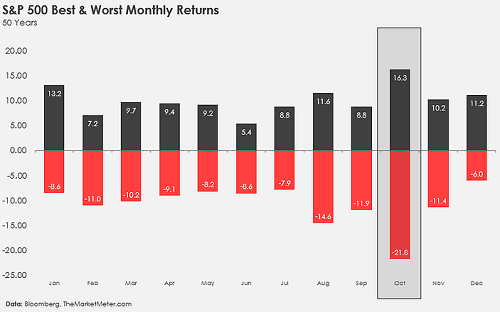It's October, no wonder stocks are making a big move
The bulls can be forgiven for taking a beat to catch their breath on Wednesday. They've built an impressive rally out of the late-September lows worth nearly 8 percent -- pushing out of the trading range that has held stocks captive since August.
For investors watching at home, it's not exactly clear what the catalyst for the surge is. Could this be yet another extreme move in October, a month noted for wild downs -- and ups? Perhaps we can shed some light on the dynamics in play this time around.
On the surface, the move up is a head-scratcher.
The Federal Reserve is still suggesting it could raise interest rates this year for the first time since 2006. Corporate earnings are expected to post their first back-to-back quarterly decline since 2009. Economic data has stalled as indicated by weak payrolls, retail sales, trade balance and Fed regional manufacturing activity surveys.
Commodity prices remain weak. China is a concern. And biotech stocks, a momentum favorite all year, are under increasing political pressure, and Valeant (VRX) was in the news after an analyst report accused the company of fraudulent accounting gimmicks, which it denied.
Moreover, despite being the month showing the highest returns on the S&P 500 (at +16.3 percent) over the past 50 years, it has also had the worst returns (at -21.8 percent), as shown in the chart below. No wonder so many investors think of October as a scary month for stocks: It contained the Panic of 1907, the 1929 crash, 1987's Black Monday, the 1997 Asian crisis mini-crash and the October 2007 start of the last bear market.
Yet at their core, stocks are a future discounting mechanism. Their prices fluctuate based on the outlook for earnings and interest rates with deviations fueled by emotional swings between fear and greed.
What happened in late September is that fear got a little too extreme. Weak economic data pushed futures market odds of the first rate hike to March 2016 or beyond, and beaten down areas of the market such as energy, industrials and materials stocks benefited from a rapid, short-covering surge as hedge fund types were forced to aggressively buy to close out their bets against the market.
According to NYSE data, short interest in September -- that is, traders borrowing shares to sell in an active bet that their prices will drop -- lifted to levels not seen since the financial crisis. It was the largest one-month increase in short positions since the market fracas surrounding the debt ceiling standoff and U.S. credit rating downgrade in 2011.
Remnants of this excessive fear can be still be seen. Jason Goepfert at SentimenTrader notes that small traders (dubbed "dumb money" because they tend to get their market timing wrong) continue to bet heavily against stocks, based on options market activity on a level not seen since 2008.
In his words, "as long as we see such extreme pessimism among historically overemotional traders, it seems the likelihood of a sustained and meaningful decline is diminished."
What about the fundamentals?
While there have been some notable misses, including American Express (AXP) and Yahoo (YHOO), the third-quarter earnings season has been surprisingly good: According to FactSet (downloadable pdf), of the 58 S&P 500 companies that have announced results through last week, 81 percent have reported better-than-expected earnings, while 50 percent have reported better-than-expected revenues.
As for the economy, the strength of the consumer looks underappreciated.
While much was made of September's relatively weak U.S. retail sales -- with sales minus autos, gasoline and building materials down 0.1 percent over August -- Capital Economics notes that third-quarter inflation-adjusted consumption growth is still clocking in at about a 3 percent annualized rate. Not quite the 3.6 percent rate it was previously expecting, but "still healthy enough" in the firm's words.
Moreover, U.S. GDP growth has been solid, with the second quarter coming in at a seasonally adjusted annualized rate of 3.9 percent -- the best result since third-quarter 2014, thanks to consumer spending.
Yet with inflation low and some manufacturing data weak, the Fed is widely expected to keep interest rates near zero percent through the beginning of next year. Short-term interest rates aren't expected to rise past 0.5 percent, representing two rate hikes, for more than a year.
As for October's bad reputation, it's more accurate to remember that it's a month of extremes. We'll know soon enough whether October 2015 joins that tradition.

